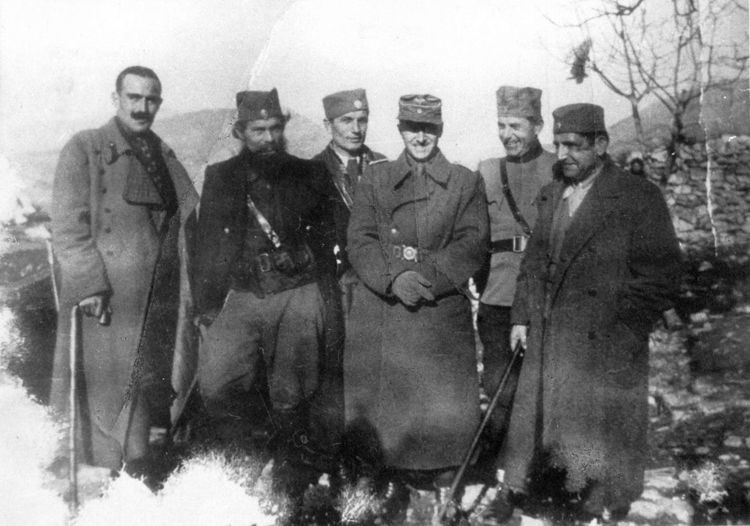Native name Ђorђiјe Lashiћ Rank Major | Years of service 1924–43 Name Dorde Lasic | |
 | ||
Born 5 May 1906 ( 1906-05-05 ) Died 5 May 1944(1944-05-05) (aged 38) Allegiance Kingdom of Yugoslavia (1918–41)
Yugoslav Communists (1941)
Chetniks (1941–43)
Italy (1942–43)
Nazi Germany (1943–44) Battles/wars World War II in Yugoslavia:
Uprising in Montenegro | ||
Intervju or e la i i vuk lon arevi www designed rs
Đorđe Lašić or Đorđije Lašić (1906 – 1944) was a Montenegrin Serb military officer of the Royal Yugoslav Army. During the Second World War he participated in the 1941 Uprising in Montenegro as one of the main adviser and instructor of insurgents' forces, and later in collaboration with Axis occupation until his death in 1944.
Contents
- Intervju or e la i i vuk lon arevi www designed rs
- Early life
- Uprising in Montenegro
- Collaboration with Axis occupation
- References
Early life

Lašić was born in village of Kami near Andrijevica, Principality of Montenegro. He completed his primary education in Lijeva Rijeka. He started his secondary education in Berane Gymnasium, but due to his bad financial situation he left school in 1918 and enrolled in military school in Ćuprija which he completed in 1922.
Uprising in Montenegro
At the beginning of June 1941 he met with the other officers of Royal Yugoslav Army to discuss potential actions against the occupying Axis forces in Montenegro.
According to Cavallero, most of the insurgent forces were led by former officers of the Kingdom of Yugoslavia until the end of October 1941. During preparation for uprising in Montenegro, CPY came in touch with active and reserve officers of the former Yugoslav army, because there were many young people in the ranks of the insurgents who did not know how to handle a firearm. Thus Lašić became a member of the communist Military Committee for Andrijevica. When Albanian quisling units started to concentrate toward the liberated territory, Lašić was co-opted in the District Military Command. Lašić often spoke out against the communist leadership of the uprising. The leadership itself didn't have illusion of a prolonged cooperation with Lašić, but they were trying not to aggravate relations with him until the rebels liberate Plav and Gusinje. When the Italian army began its offensive against the rebels, Lašić on 4 August abandoned his position in partisan District Military Command and joined the anti-communist group of Ljubo Vuksanović, who opposed further struggle against Axis occupation. After partisan withdrawal from Berane and Andrijevica in early August, Lašić was a member of the delegation sent to meet the Italian army. On 5 September Lašić in Lijeva Rijeka gathered people and called for combat against communist rebels.
After the initial major success, uprising organized and led by Communists was suppressed within three weeks. Most nationalist commanders took neither side in the sporadic clashes between Italian forces and insurgent forces that became increasingly dominated by Partisans. Lašić went to Ravna Gora in Serbia to meet Chetnik leader Draža Mihailović. In mid-October 1941 Draža Mihailović appointed Lašić as commander of Chetniks in (Old) Montenegro. Although some evidence suggest that nationalist officers advised civilians to take passive attitude toward Italian forces, there is no indication that they were to collaborate with Italians and their governor Alessandro Pirzio Biroli.
In Lijeva Rijeka (former municipality near Podgorica) Lašić established the first Chetnik military organization at the end of November and Chetnik battalion (Battalion of Lijeva Rijeka) at the beginning of December 1941. He was the first commander of this battalion, which was the first Chetnik battalion in Montenegro.
Collaboration with Axis occupation
In the second half of December 1941, Pavle Đurišić and Lašić began the mobilization and establishment of armed units separated from Partisans. By the middle of January 1942 these units were in armed conflict with Partisans. Lašić was heavily wounded when two companies of the Kom Partisan detachment attacked Chetniks in Bare Kraljske (near Kolašin), so the command of Chetnik forces at this sector was transferred to Andrija Vesković.
In period between German capture of Pavle Đurišić on 14 May 1943, during their Case Black operation, and his return from German prison in November 1943, Lašić was the only remaining Chetnik commander in Montenegro. His forces were probably no more than 500 men.
Lašić was killed on 5 May 1944 during the bombing of Podgorica by Allies.
